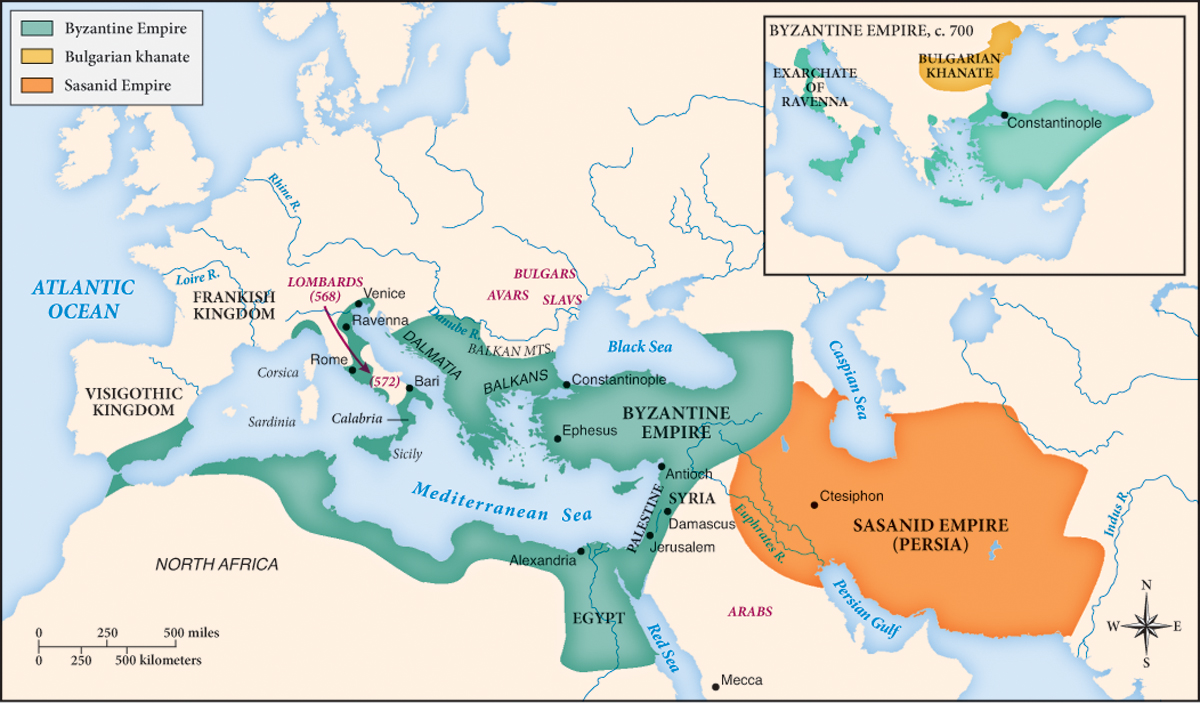Wars on the Frontiers, c. 570–750
Wars on the Frontiers, c. 570–750
From about 570 to 750, the Byzantines waged war against invaders. One key challenge came from an old enemy, Persia. Another involved many new groups—Lombards, Slavs, Avars, Bulgars, and Muslims. In the wake of these onslaughts, Byzantium became smaller but tougher.
Before the Muslims came on the scene, the principal challenge to Byzantine power came from the Sasanid Empire of Persia (Map 8.2). From their capital city at Ctesiphon, where they built a grand palace complex, the Sasanid kings promoted an exalted view of themselves: they took the title King of Kings and gave the men at their court titles such as priest of priests and scribe of scribes. With dreams of military glory, they invaded major areas of the Roman Empire, using the revenues from new taxes to strengthen the army. King Chosroes II (r. 591–628) took Syria and Jerusalem between 611 and 614, and he conquered Egypt in 620.

Responding to these attacks, the Byzantine emperor Heraclius (r. 610–641) reorganized his army and inspired his troops to avenge the sack of Jerusalem. By 627, the Byzantines had regained all their lost territory. But the wars had changed much: Syrian, Egyptian, and Palestinian cities had grown used to being under Persian rule, and Christians who did not adhere to the orthodoxy at Byzantium preferred their Persian overlords. Even more important, the constant wars and plundering sapped the wealth of the region and the energy of the people who lived under Byzantine rule.
Preoccupied by war with Persia, Byzantium was ill equipped to deal with other groups who were pushing into parts of the empire at about the same time. The Lombards, a Germanic people, entered northern Italy in 568 and by 572 were masters of the Po valley and parts of Italy’s south. In addition to Rome, the Byzantines retained only Italy’s “foot,” the island of Sicily, and a narrow swath of land through the middle of the peninsula called the Exarchate of Ravenna.
The Byzantine army could not contend any better with the Slavs and Bulgars just beyond the Danube River. Joined by the Avars, the Slavs attacked both rural and urban areas of Byzantium. Meanwhile, the Bulgars entered what is now Bulgaria in the 670s, defeating the Byzantine army and in 681 forcing the emperor to recognize their new state.
Even as the Byzantine Empire was facing military attacks on all fronts, its power was being whittled away by more peaceful means. As Slavs and Avars, who were not subject to Byzantine rulers, settled in the Balkans, they often intermingled with the native peoples there, absorbing local agricultural techniques and burial practices while imposing their language and religious cults.
Byzantium’s loss of control over the Balkans meant the shrinking of its empire (see inset on Map 8.2). It also exacerbated the growing separation between the eastern and western parts of the former Roman Empire. Avar and Slavic control of the Balkans effectively cut off trade and travel between Constantinople and the cities of the Dalmatian coast, while the new Bulgarian state served as a political barrier across the Danube. The two halves of the former Roman Empire communicated very little in the seventh century, a fact reflected in their different languages: Greek in the East, Latin in the West.